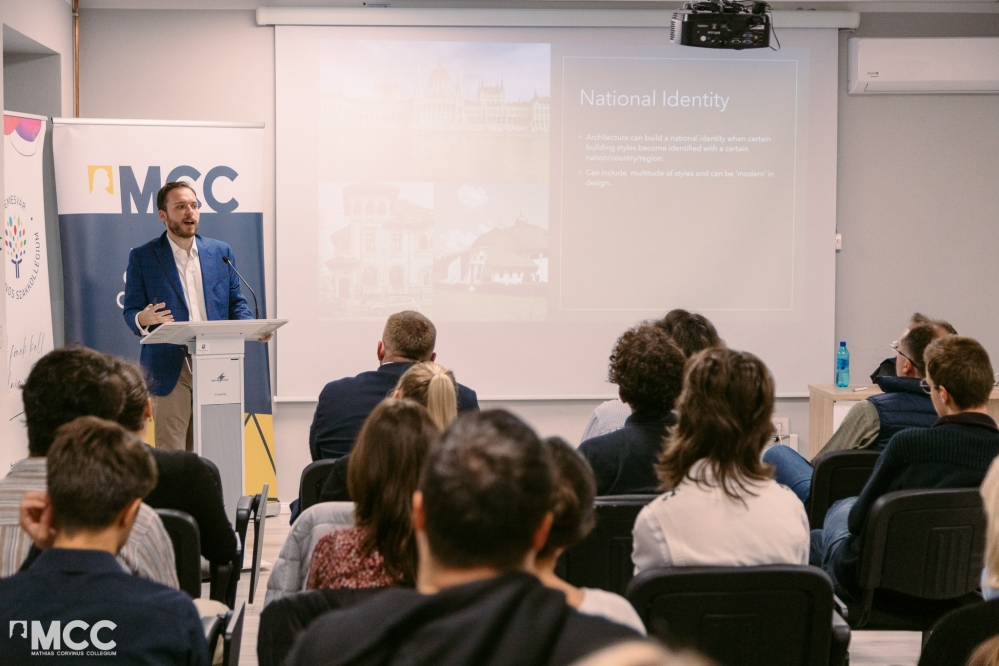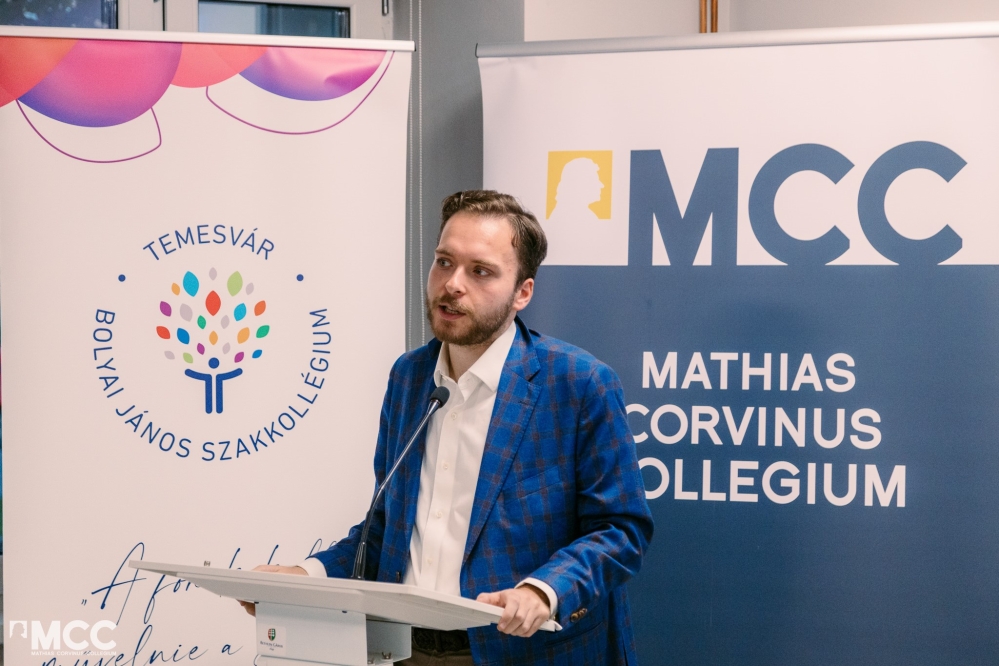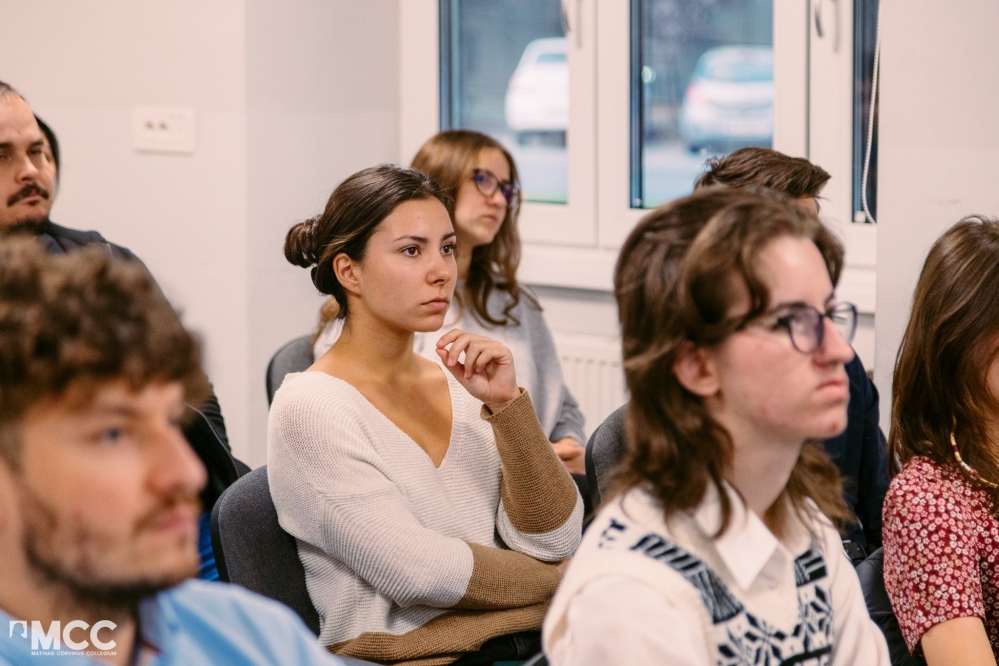Reading time: 5 minutes
We may not realize in our everyday lives how much architecture influences our society, our cultural and political life. Recent trends in architecture are increasingly distancing themselves from local, regional and national identities, said Stephen Travis Sholl, visiting fellow at MCC, in his lecture The Role of Architecture in National Identity in Timisoara. The event on Wednesday 19 October was organized in partnership between Mathias Corvinus Collegium (MCC) and the Bolyai János College.
Stephen Sholl studied history and international relations, so he approached the subject from his own field of expertise, rather than as an architect. The lecture analyzed the relationship between architecture and community identity, looking at both constructive and destructive influences. Stephen Travis Sholl is an MA student at the Virginia Tech School of Public and International Affairs, and previously studied International Conflict and Security Studies at the Brussels School of International Studies at the University of Kent, and holds a BA in History from Freed-Hardeman University. In 2021 he was a fellow of the Budapest Fellowship Program, a joint fellowship program of the Hungary Foundation and MCC. During his studies and work in Washington and Brussels, much of his academic research has focused on transatlantic relations and Central Europe. His first thesis was on the impact of memory politics on Hungarian foreign policy.
At the event, the lecturer first demonstrated with pictures that we can recognize the distinctive buildings and styles of countries and regions at first sight. He pointed out that some types of architecture contribute to building culture, while others destroy it. Architecture can build collective identity at a local, regional, national or even civilizational level. When we see some buildings, we instinctively identify the styles from different parts of the world, but we can also recognize a mix of these styles. Transylvanian towns are a good example, where, whatever the demographic indicators may be, beside the presence of Orthodox and Romanian architecture, the symbolic buildings of the town indicate that Hungarians lived and built there. And the synagogues also add to the overall picture. The buildings are therefore a way of establishing local history and collective identity.
On the other hand, most of the newer buildings can’t be linked to any specific place or culture. "They could be anywhere," agreed the audience. Modern architecture therefore suppresses national identity. Since the Second World War, a kind of international style has dominated on both sides of the Iron Curtain, abandoning all ornamentation and concentrating on functionality. Just as the last century saw the emergence of nondescript concrete buildings, today's cities have become a collection of glass skyscrapers. Stephen Sholl added: Contemporary architecture deliberately seeks to distance itself from the old styles. In many cases, there is no attempt to integrate the new into its surroundings, to keep the old forms.
Important community buildings, in particular, should reflect local culture, but this requires dialogue with local leaders and architects. Surveys in Western countries show that the majority of people prefer old styles and that there is a need for uniqueness, beauty and a liveable, welcoming environment.
Stephen Sholl's presentation was part of the MCC's public events in several cities. The US speaker had a discussion in Szatmárnémeti/ Satu Mare too, on October the 20th. Those who are interested can participate in several events organized by MCC: A teachers' conference is taking place in Oradea, and in the coming weeks, Dr. Rajmund Kiss, head of the Center for Diplomatic Studies, MCC, journalist Boris Kálnoky, economist Dr. Géza Sebestyén and philosopher Dr. Gábor Csepregi will also have discussions in Marosvásárhely/ Târgu Mures, Kolozsvár/ Cluj Napoca, Csíkszereda/ Miercurea Ciuc and Sepsiszentgyörgy/ Sfântu Gheorghe. The Transylvania Lectures series also continues in Cluj-Napoca: US philosopher and author Dr. Peter Boghossian will be the next guest of the MCC.
"The Mathias Corvinus Collegium has started the new academic year with great momentum. We try to be present in all major cities and, in addition to our educational activities, to respond to the requests and needs of local communities and to address issues of interest to communities in Transylvania," said Botond Talpas, general director of MCC Transylvania, expressing his gratitude that the organization has succeeded in mobilizing open-minded and interested people. In Temesvár, the Bolyai János College has proved to be a good partner, and the MCC's programs at the Hungarian Cultural Days in Temesvár were also successful, where the Youth Talent Program provided a spectacular interactive science session for local children keen to experiment.
"The event was based on the needs of the students. As most of the College’s residents study at technical universities, many of them architecture, the presentation resonated with the young people. The feedback has been positive, so we sincerely hope to continue our fruitful cooperation with Mathias Corvinus Collegium," said Attila Somogyi, Program Coordinator of the Bolyai János College. He added that preparations are already underway for another joint lecture, and the cooperation between the College and the MCC is a valuable initiative to respond to the needs of local groups in the Temesvár region.
For more information on the activities and events of the MCC, please visit the Mathias Corvinus Collegium – Erdély Facebook page.



